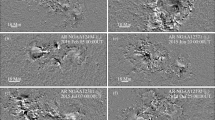Abstract
In this paper, the magnetic-field and electric-current parameters are calculated for a sample of 73 active regions (ARs) of solar activity cycle 24 based on magnetographic data from the Helioseismic and Magnetic Imager (HMI) instrument aboard the Solar Dynamics Observatory (SDO). The calculated values are compared to the level of flare productivity and features of the AR morphology. The following results are obtained. (1) The imbalance of local vertical electric currents in the regions of the studied sample does not exceed a few percent (the maximum obtained value is 8.08%), in contrast to the magnetic-flux imbalance, which can reach a few tens of percent (the maximum absolute value is 82.11%). (2) The highest correlation of the calculated parameters of electric current with the level of AR flare productivity is observed for the total unsigned vertical electric current \(\overline {{{I}_{{z\,{\text{tot}}}}}} \) (a Pearson correlation coefficient of k = 0.67) and the average unsigned vertical electric current density \(\left\langle {\overline {\left| {{{j}_{z}}} \right|} } \right\rangle \) (k = 0.66), which are averaged over the AR monitoring period. (3) It is shown that the values of the electric-current parameters for the Ars in which the basic empirical laws of the Babcock–Leighton dynamo theory are violated are higher than the corresponding values of the electric current parameters for the regular ARs. This result may indicate that there is additional energy pumping by the local dynamo mechanisms in the irregular regions.




Similar content being viewed by others
REFERENCES
Abramenko, V.I., Relationship between magnetic power spectrum and flare productivity in solar active regions, Astrophys. J., 2005, vol. 629, no. 2, pp. 1141–1149.
Abramenko, V.I., Zhukova, A.V., and Kutsenko, A.S., Contributions from different-type active regions into the total solar unsigned magnetic flux, Geomagn. Aeron. (Engl. Transl.), 2018, vol. 58, no. 8, pp. 1159–1169.
Aulanier, G., Démoulin, P., and Grappin, R., Equilibrium and observational properties of line-tied twisted flux tubes, Astron. Astrophys., 2005, vol. 430, pp. 1067–1087.
Bobra, M.G., Sun, X., Hoeksema, J.T., et al., The Helioseismic and Magnetic Imager (HMI) vector magnetic field pipeline: SHARPS—Space-Weather HMI Active Region Patches, Sol. Phys., 2014, vol. 289, no. 9, pp. 3549–3578.
Cheung, M.C.M. and Isobe, H., Flux emergence (theory), Living Rev. Sol. Phys., 2014, vol. 11, no. 1, p. 3.
Dalmasse, K., Aulanier, G., Demoulin, P., et al., The origin of net electric currents in solar active regions, Astrophys. J., 2015, vol. 810, no. 1, p. 17.
Fursyak, Yu.A., Vertical electric currents in active regions: Calculation methods and relation to the flare index, Geomagn. Aeron. (Engl. Transl.), 2018, vol. 58, no. 8, pp. 1129–1135.
Fursyak, Yu.A. and Abramenko, V.I., Possibilities for estimating horizontal electrical currents in active regions on the Sun, Astrophysics, 2017, vol. 60, no. 4, pp. 544–552.
Fursyak, Yu.A., Abramenko, V.I., and Kutsenko, A.S., Dynamics of electric current’s parameters in active regions on the Sun and their relation to the flare index, Astrophysics, 2020, vol. 63, no. 2, pp. 260–273.
Hale, G.E., Ellerman, F., Nicholson, S.B., and Joy, A.H., The magnetic polarity of sun-spots, Astrophys. J., 1919, vol. 49, pp. 153–185.
Hoeksema, J.T., Liu, Y., Hayashi, K., et al., The Helioseismic and Magnetic Imager (HMI) vector magnetic field pipeline: Overview and performance, Sol. Phys., 2014, vol. 289, no. 9, pp. 3483–3530.
Leka, K.D., Canfield, R.C., McClymont, A.N., and van Driel-Gesztelyi, L., Evidence for current-carrying emerging flux, Astrophys. J., 1996, vol. 462, pp. 547–560.
Longcope, D.W. and Welsch, B.T., A model for the emergence of a twisted magnetic flux tube, Astrophys. J., 2000, vol. 545, no. 2, pp. 1089–1100.
McClymont, A.N. and Fisher, G.H., On the mechanical energy available to drive solar flares, in Solar System Plasma Physics: Geophysical Monograph Series 54, Waite, J.H., Jr., Burch, J.L., and Moore, R.L., Eds., Washington, DC: American Geophysical Union, 1989, pp. 219–225.
McIntosh, P.S., The classification of sunspot groups, Sol. Phys., 1990, vol. 125, no. 2, pp. 251–267.
Norton, A.A., Jones, E.H., Linton, M.G., and Leake, J.E., Magnetic flux emergence and decay rates for preceder and follower sunspots observed with HMI, Astrophys. J., 2017, vol. 842, no. 1, p. 3.
Pesnell, W.D., Thompson, B.J., and Chamberlin, P.C., The Solar Dynamics Observatory (SDO), Sol. Phys., 2012, vol. 275, pp. 3–15.
Scherrer, P.H., Schou, J., Bush, R.I., et al., The Helioseismic And Magnetic Imager (HMI) investigation for the Solar Dynamics Observatory (SDO), Sol. Phys., 2012, vol. 275, nos. 1–2, pp. 207–227.
Schrijver, C.J., DeRosa, M.L., Metcalf, T., et al., Nonlinear force-free field modeling of a solar active region around the time of a major flare and coronal mass ejection, Astrophys. J., 2008, vol. 675, no. 2, pp. 1637–1644.
Török, T. and Kliem, B., The evolution of twisting coronal magnetic flux tubes, Astron. Astrophys., 2003, vol. 406, pp. 1043–1059.
Wang, J., Shi, Z., Wang, H., and Lue, Y., Flares and the magnetic nonpotentiality, Astrophys. J., 1996, vol. 456, pp. 861–878.
Zaitsev, V.V., Stepanov, A.V., Urpo, S., and Pohjolainen, S., LRC-circuit analog of current-carrying magnetic loop: Diagnostics of electric parameters, Astron. Astrophys., 1998, vol. 337, pp. 887–896.
Zhukova, A.V., Catalog of active regions of solar cycle 24, Izv. Krym. Astrofiz. Obs., 2018, vol. 114, no. 2, pp. 74–86.
ACKNOWLEDGMENTS
The authors are grateful to the reviewers of the paper for their interest in the study, their helpful comments, and their time.
Funding
The paper was partially supported by the Russian Science Foundation, project no. 18-12-00131, and by the Ministry of Science and Higher Education of the Russian Federation, project no. 0831-2019-0006.
Author information
Authors and Affiliations
Corresponding author
Ethics declarations
The authors declare that they have no conflicts of interest.
Additional information
Translated by N. Semenova
Rights and permissions
About this article
Cite this article
Fursyak, Y.A., Abramenko, V.I. & Zhukova, A.V. Parameters of Electric Currents in Active Regions with Different Levels of Flare Productivity and Different Magnetomorphological Types. Geomagn. Aeron. 61, 1197–1206 (2021). https://doi.org/10.1134/S0016793221080089
Received:
Revised:
Accepted:
Published:
Issue Date:
DOI: https://doi.org/10.1134/S0016793221080089



